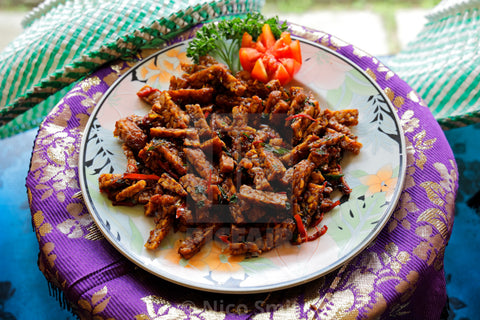
Where can I get Tempeh in India?
Table Of Content
With changing times, many people are switching to authentic and nutritious food because of the many benefits it offers. Tempeh is one such item that is gaining rapid popularity in the present time.
Tempeh, an Indonesian dish made from fermenting beans is well known for it's high-protein content and is the perfect choice for the ones looking to incorporate plant- based proteins.

I was thrilled to find Tempeh in India and have been a huge fan of the same since I found it. Let's together explore a little bit about what this is and how to make your own Tempeh at home!
What Is Tempeh?
Tempeh is an Indonesian food made using fermented beans (mostly soybeans). To make Tempeh, soybeans are fermented using a fungus called Rhizopus oligosporus or Tempeh starter. This fungus helps bind the soybeans together and gives it a cake-like structure.
If you visit the island of Java, you will find that people have Tempeh as a crucial part of their diet. It is one of the essential sources of protein for the Javan population.

Many people tend to compare Tempeh with Tofu as both the products are made using soybeans. However, they are not the same in terms of nutritional values and texture. The nutrients in Tempeh are slightly more than in Tofu due to its fermentation process. This process allows the retention of the full beans and thus higher proteins, dietary fibre and vitamin content. People who consume Tempeh say that it has an earthy flavour that becomes stronger as the product ages. If you compare Tempeh with Tofu, you will notice that Tempeh has a firmer and grainer texture than Tofu. It took me sometime to develop a taste for Tempeh and I am a huge tofu lover.
Origin of Tempeh
As mentioned before, Tempeh is an Indonesian dish and is popular in the eastern part of Java. There is not an accurate description of when and how the dish came about, and some people believe that Tempeh originated thousands of years ago.

However, the earliest reference to a dish called Tempeh goes back to 1815, in the Serat Centhini. It originated as a byproduct of the Tofu production. According to historians, leftover soybeans caught spores of the whitish fungus, and people found the resulting product to be edible. The flavour and texture of this accidental dish were unique, and people of Java started to make this dish deliberately ever since.
Benefits of Tempeh
Tempeh gained popularity worldwide because of the high protein and dietary fibre content of the dish. Here are some of it's benefits:
- Easy to digest - First of all, the soy carbohydrates in Tempeh become easy to digest thanks to the fermentation process. The Rhizopus culture used to produce Tempeh helps in reducing the concentration of oligosaccharides associated with gas and indigestion.
- Rich in vitamin B12 - Vitamin B12 is an essential element required in our body; however, our bodies cannot produce this nutrient on this own. Tempeh is an excellent source of the vitamin and hence, the perfect supplement for it. If you visit a traditional Tempeh-making shop, you will see that the culture used to produce the dish contains bacteria that produce vitamin B12 in adequate quantities.
- Easy absorption of minerals - The fermentation process used to create Tempeh reduces the phytic acid content of the soybeans. This reduction in phytic acid allows our bodies to absorb the minerals present in soy easily.
- Reduced cholesterol levels - Isoflavones derived from soybeans are a plant compound that help reduce bad cholesterol levels. Since Tempeh is traditionally prepared from soybeans, it is believed to aid people with high cholesterol levels. Isoflavone, on the other hand, may also help in managing oxidative stress (prevent ageing).
- Promotes bone health - With high levels of calcium, Tempeh may promote bone health by keeping them strong and dense.
Nutrition Chart: 100g of Tempeh provides you with approximately 192 Kcal of energy
|
Nutrient |
Amount in 100g of Tempeh |
|
Carbohydrates |
7.64g |
|
Fat |
10.8g |
|
Protein |
20.29g |
|
Vitamin B1 (Thiamine) |
0.078mg |
|
Vitamin B2 (Riboflavin) |
0.358mg |
|
Vitamin B3 (Niacin) |
2.640mg |
|
Vitamin B6 |
0.215mg |
|
Vitamin B9 (Folate) |
0.024mg |
|
Vitamin B12 |
0.08μg |
|
Calcium |
111mg |
|
Iron |
2.7mg |
|
Magnesium |
81mg |
|
Manganese |
1.3mg |
|
Phosphorus |
266mg |
|
Potassium |
412mg |
|
Sodium |
9mg |
|
Zinc |
1.14mg |
|
Water |
59.9g |
Where to Get Tempeh In India?
Owing to its increase in popularity and health benefits, you can buy Tempeh in major cities across India.
- TempehWala - If you are looking for organic versions of Tempeh, you can reach out to Tempewala, Bangalore. They emphasise on keeping Java's heritage alive with their Tempeh which is delivered in eco-friendly packaging.
- Tempedimumbai -This place is run by a lovely Indonesian family who commit to keep their culture alive through the food they serve. This is the first place to also offer mung beans tempeh and deliver in and around Mumbai. Their product is very reasonable and extremely delicious.
Apart from the above, you will find tempeh in various vegan restaurants such as The Real Green Cafe in Pune, The Philosophy Club in Ahmedabad, Farmer’s Cafe in Mumbai, Bean Me Up in Goa, The Holy Tree in Ludhiana. Ask them nicely and most of them will gladly pack some raw tempeh for you to take home and experiment your own recipes.
How to Make Tempeh at home Yourself?
Creating your own Tempeh from scratch is a tricky process. Indonesian people prepare a variety of Tempeh using different processes. The regular Tempeh only involves fermentation, whereas Tempeh Semangi, a delicacy in Java involves a longer fermentation and the use of a unique blend of spices.

People prepare Tempeh Kedelai using soy pulp or Tofu to prepare an inferior variety of Tempeh. Similarly, Oncom is a type of Tempeh that you can make using peanut press cakes. Oncom is quite popular in West Java.
There are several ways to make Tempeh, and they involve different processes. It won't be possible to discuss all the methods to prepare this dish, so will we stick to the common Tempeh.
It is actully really simple to make Tempeh at home, but sure takes time. Refer to the below recipe video for details:
- The first step in preparing common Tempeh involves soaking the soybeans. Once this process is complete, you need to de-hull the resultant product and then cook it partially.
- Traditionally, Javans make Tempeh using soybeans, but you can also use other beans, wheat and a mixture of whole grains to prepare Tempeh.
- Post the soaking and cooking process, you need to ferment the soybeans to help it turn into Tempeh. The fermentation process involves Rhizopus spp. moulds. It is a type of filamentous fungus that people use to make Tempeh.
- You can get a tempeh starter from Amazon and use it to start making your Tempeh. Mix this starter with the base product that you got after soaking and partially cooking soybeans. Once you mix the ingredients thoroughly, you need to spread it out in a thin layer and let it ferment anywhere between two to three days at a temperature around 30 degrees celsius.
- As the soybean and spore mixture cools down, the fungus starts to grow over the mixture. After a day or two, the temperature of the mixture will start increasing and moulds will multiply. This increase in temperature and mould growth would last for about three to four hours.
- Once the mould growth subsides, the mycelium will bind the soybeans into a solid mass. During this stage, if you have followed the instructions correctly, you will notice that the mycelium has bound the soybeans in a whitish blanket like structure.
- When you harvest the Tempeh after 48 hours, the product would have a unique whitish colour and a firm texture, along with a nutty flavour. Be sure to harvest Tempeh within three to four days to avoid over fermentation that gives the Tempeh a higher pH and dark colour.
What to Look for While Making Tempeh at Home?
- Setting an optimum temperature, oxygen, humidity level, and pH is a crucial process to get the best results. You should also consider the time you let the soybean and starter mixture to ferment.
- To make good-quality Tempeh, you need a pH level of 3 to 5. You can change the pH by adding vinegar or lactic acid to the mix. This pH level helps in killing the undesirable microbes present in the starter kit. Plenty of Oxygen is also crucial for fungal growth, so keep the mixture in a nicely-ventilated space. 30 degrees Celsius is also needed for the best result.
- If you don't ensure proper ventilation and temperature for the Tempeh, you will notice a darker colour growth on the surface. It is not harmful, and it only means that you allow excess fermentation. Still, you can consume this Tempeh without worrying about any health issues.
- Properly fermented Tempeh should have a slight ammonia-like smell that is not overpowering.
Once you the process is completed, you can use this Tempeh to create your dishes that are healthy and tasty and derive the best of health benefits right from the land of Java!
To checkout vegan high protein fitness plan, click here.
Comment your experience with tempeh below and I will reply back with a tempeh recipe you can try!
Also, comment below if you are selling tempeh in India and we have missed mentioning you in the blog.
(Co-Authored by SEO Singh.)
Let's Just Talk. No Obligations.
I do free consultations every Tuesday's and Thursday's. Either way you will get some actionable tips to reach your fitness goals faster.



Comments
Leave a comment